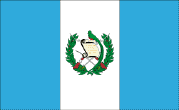
Guatemala

|
Guatemala History |
Click on map to see it in detail |
| Guatemala History |
Once the site of an impressive ancient Mayan civilization, Guatemala was conquered by Spanish conquistador Pedro de Alvarado in 1524 and became a republic in 1839 after the United Provinces of Central America collapsed. From 1898 to 1920, dictator Manuel Estrada Cabrera ran the country, and from 1931 to 1944, Gen. Jorge Ubico Castaneda served as strongman. After Ubico's overthrow in 1944 by the "October Revolutionaries," a group of left-leaning students and professionals, liberal-democratic coalitions led by Juan José Arévalo (1945–1951) and Jacobo Arbenz Guzmán (1951–1954) instituted social and political reforms that strengthened the peasantry and urban workers at the expense of the military and big landowners like the U.S.-owned United Fruit Company. With covert U.S. backing, Col. Carlos Castillo Armas led a coup in 1954, and Arbenz took refuge in Mexico. A series of repressive regimes followed, and by 1960 the country was plunged into a civil war between military governments, right-wing vigilante groups, and leftist rebels that would last 36 years, the longest civil war in Latin American history. Death squads murdered an estimated 50,000 leftists and political opponents during the 1970s. In 1977, the U.S. cut off military aid to the country because of its egregious human rights abuses. The indigenous Maya Indians were singled out for special brutality by the right-wing death squads. By the end of the war, 200,000 citizens were dead. A succession of military juntas dominated during the civil war, until a new constitution was passed and civilian Marco Vinicio Cerezo Arévalo was elected and took office in 1986. He was followed by Jorge Serrano Elías in 1991. In 1993, Serrano moved to dissolve Congress and the Supreme Court and suspend constitutional rights, but the military deposed Serrano and allowed the inauguration of Ramiro de Leon Carpio, the former attorney general for human rights. A peace agreement was finally signed in Dec. 1996 by President Álvaro Arzú Irigoyen. In 1999, a Guatemalan truth commission blamed the army for 93% of the atrocities and the rebels (the Guatemalan National Revolutionary Unit) for 3%. The former guerrillas apologized for their crimes, and President Clinton apologized for U.S. support of the right-wing military governments. The army has not acknowledged its guilt. Alfonso Portillo Cabrera, closely associated with the former dictatorship of Efrain Rios Montt (1982–1983), became president in Jan. 2000. In Aug. 2000, Portillo apologized for the former government's human rights abuses and pledged to prosecute those responsible and compensate victims. To stimulate the economy, Guatemala, along with El Salvador and Honduras, signed a free trade agreement with Mexico in June 2000. In Aug. 2001, plans for tax increases prompted widespread, and often violent, protests. In July 2003, the country's highest court ruled that former coup leader and military dictator Efrain Rios Montt, responsible for a massacre of tens of thousands of civilians during the civil war, was eligible to run for president in November. The ruling conflicted with the constitution, which bans anyone who seized power in a coup from running for the presidency. But in November, Rios Montt was soundly defeated by two candidates, conservative Oscar Berger and center-leftist Alvaro Colom. In the run-off election in December, Berger was elected president. |
| Origin of the name, Guatemala | The origin of the name Guatemala is Indian, but its derivation and meaning are undetermined. Some hold that the name Guatemala means land of the trees in the Maya-Toltec language. Another thought is that the Nahuatl expression Quauhtitlan, which means "between the trees," gave the name to what we now know as Guatemala. That was the name the Tlaxcaltec soldiers who accompanied Pedro de Alvarado during the Spanish Conquest gave to this territory, perhaps translating into their language the word "Quiche," which means "many trees." One other idea is that Guatemala’s name is a Spanish corruption of the Nahoa (Mexican) word coactlmoctl-lan, meaning "land of the snake-eating bird," a phrase that refers to the country’s eagle. |
Click on each link below to learn more about the symbols.
|
|
|
Guatemala is divided in 22 departments |
Department (Capital)
|
| Spanish is the official language and there are 22 Mayan languages. | |
|
Guatemala ’s biggest business is the export of coffee. Coffee is grown mainly on the Pacific slope and in the department of Alta Verapaz. Other export crops include sugar, cotton, flowers, natural rubber and bananas with 50% of the population working in agriculture. The Motagua Valley also supports banana and sugarcane plantations and the rolling hills of Alta Verapaz also support dairy farming. Tourism is the second largest industry with 35% of the population employed in services. The remaining 15% are employed by industry with Guatemala City being the industrial and commercial center of the country. The El Peten department in the north depends mostly upon tourism and as it is in this area that the great ruins of Tikal are located. Guatemala suffers from the regional legacy of the "banana republic": the inequitable distribution of land and wealth, uneven development, and the dependence on a few export crops for its economy mainstay. The poor distribution of land is the single most important factor to explain the poverty and quality of life in Guatemala. Nearly 90 percent of the farms are too small to provide adequate subsistence, while 2 percent of the farms use up 65 percent of the land. Find out how much your money is worth in Guatemala Quetzals. Click here! |
|
Guatemala Links |
Guatemala in Pictures |
Maya Recipes |
|
|
Source: Wikpedia the free Encyclopedia, InfoPlease.com, Government of Guatemala
Kim and Don Greene, Contributors; publication date February 2005